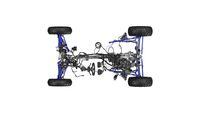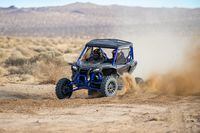To understand the value of Live Valve, we have to see the special problems of a short-wheelbase vehicle with long-travel suspension. Honda's Talon 1000X has an 87.6-inch wheelbase, much shorter than the typical 122- to 145-inch wheelbase of pickup trucks. Combined with Talon's long 14.6/15.1-inch front and rear suspension travel, uncomfortably large changes in pitch and roll are possible.
The value of long-travel suspension is that it makes rough going much smoother for us humans inside the vehicle. Wheels rise and fall easily over bumps while transmitting much less motion to the vehicle. Also, in general, the softer the suspension, the better the mechanical grip the tires have on the trail. But suspension soft enough to do those things well is also soft enough to pitch forward during hard braking or roll to the side during hard turning.
Cars and light trucks minimize forward pitch by having a much longer wheelbase. They deal with body roll in turns with anti-sway bars, which are torsion springs that are twisted by body roll.
During hard braking, the short wheelbase and long wheel travel of a UTV result in rapid large forward pitch that can, in extreme maneuvering, bottom the front suspension.
When a vehicle makes a hard turn, its body rolls to the outside, transferring weight from the inside to the outside wheels. This overworks the outside tires and hardly uses the inside ones at all. It is to minimize this effect that Honda’s Talon is built as wide as it is at 64 inches (versus the old US Army jeep’s 62 inches). Body roll is not only uncomfortable for us in the vehicle, but extreme cornering can also lift the inside wheels off the ground—again, interfering with control. Snowmobiles ran into this when they were given long-travel suspension, making them taller and thus easier to force into lifting a ski in hard turning.
So the problem is this: How do we keep the soft suspension that makes off-roading a thrill rather than “an all-day plane crash,” as Parnelli Jones described racing in the Baja 1000, and yet prevent excessive chassis pitch and body roll during hard maneuvering?
The traditional way to control roll and pitch was to stiffen up the suspension springs and their damping (not “dampening”—that’s what my mother did when she sprinkled water on her ironing), and in the past that’s just what people did if they wanted to go really fast. But the stiffer the suspension, the harder the ride, and the sooner everyone decides it’s lunchtime.
Fortunately there’s a better solution: a “smart” suspension that knows when to stiffen up compression damping and when to just let the shocks move normally. Fox Live Valve provides this versatility by measuring obvious variables like steer angle, brake pressure, and vehicle roll and pitch motions, interpreting them to understand what the vehicle is doing, and then varying compression damping in each individual shock to oppose just the unwanted suspension motions.
The four suspension dampers, one at each wheel, combine the usual compression and rebound damping valves with an electronic device, the Live Valve itself, that can adjust the pressure on each damper’s compression stack every five milliseconds.
When you yank the steering into a turn, the system prepares your vehicle by increasing compression damping on the outside wheels, reducing roll. When you go for the brakes, the spiking line pressure tells the system’s ECU to prepare for forward pitch by boosting compression damping on the front wheels. The system knows your engine rpm, throttle angle, what gear you’re in, and your vehicle speed, so it can add compression damping all around to prevent bottoming from rising bump forces.
The system uses a Bosch five-axis Inertial Measuring Unit (IMU) to constantly monitor roll, pitch, and yaw; G-force from braking or acceleration; and cornering load. Early IMUs of the 1950s weighed more than 1,000 pounds. By 1960, the inertial guidance units of ICBMs had been reduced to bushel-basket size, stuffed with ultraprecision spinning gyros. Today’s IMUs can weigh less than an ounce, contain no moving parts, and cost just a few dollars.
This is “semi-active suspension,” and the concept is being applied across the automotive field, enabling suspensions to adapt to changing conditions in useful ways.















/cloudfront-us-east-1.images.arcpublishing.com/octane/5RK5XYXY5FH4HEM3QZYEU2DOEE.jpg)
/cloudfront-us-east-1.images.arcpublishing.com/octane/5HSLI5PF7NB6HEUQCF6JKV2GBI.jpg)


/cloudfront-us-east-1.images.arcpublishing.com/octane/QJRGJWNKIVHR5BDHI6XC3HIN3M.jpg)
/cloudfront-us-east-1.images.arcpublishing.com/octane/SXUSRWPQ3RHMLKYLKUWXMPJQAI.jpg)
/cloudfront-us-east-1.images.arcpublishing.com/octane/SHN4TGVAR5BEHIHYFJ35TN6BIU.jpg)
/cloudfront-us-east-1.images.arcpublishing.com/octane/NYABEHCGARBTTI6MOTXCXXK33Q.jpg)
/cloudfront-us-east-1.images.arcpublishing.com/octane/XXCQGJE2DFCK7F5SCLBNEP5EG4.jpg)
/cloudfront-us-east-1.images.arcpublishing.com/octane/R5VA5TMJEVBCXHKIPP6SPSNOE4.jpg)
/cloudfront-us-east-1.images.arcpublishing.com/octane/2PYLXE5AQNFEDEBMTSQYR72NXY.jpg)
/cloudfront-us-east-1.images.arcpublishing.com/octane/GHUUAT2YCZCAPDA2KSJ5EJSD3A.jpg)
/cloudfront-us-east-1.images.arcpublishing.com/octane/CPN3RY43KZEAFKGIKTFKQPODGU.jpg)

/cloudfront-us-east-1.images.arcpublishing.com/octane/SBIPFMMOLRHJHD4NIPKGYWINVE.jpg)
/cloudfront-us-east-1.images.arcpublishing.com/octane/77OLCREQPVHLPFYS5HCD7ADEJ4.jpg)
/cloudfront-us-east-1.images.arcpublishing.com/octane/CISC3RQHYRDMHMCYSWUFYVXMMY.jpg)
/cloudfront-us-east-1.images.arcpublishing.com/octane/2VRT2BBMUBCYVB4YRHDIO4XJM4.jpg)
/cloudfront-us-east-1.images.arcpublishing.com/octane/6II3C3OZTJA2BP57AMWOMREICI.jpg)
/cloudfront-us-east-1.images.arcpublishing.com/octane/LA2VU3Z2QVC4JGOBMQEVE5N2SY.jpg)
/cloudfront-us-east-1.images.arcpublishing.com/octane/JIJBK6QN5BBALIAMWQCUUHXWUA.jpg)
/cloudfront-us-east-1.images.arcpublishing.com/octane/AG45LVZV2BHQ3NZ7NNNG52M76I.jpg)
/cloudfront-us-east-1.images.arcpublishing.com/octane/772PKIGJSVCYHMI66IWHUDGPUQ.jpg)
/cloudfront-us-east-1.images.arcpublishing.com/octane/DYT2FWE4LZBFBOIOFSQZXESMDE.jpg)